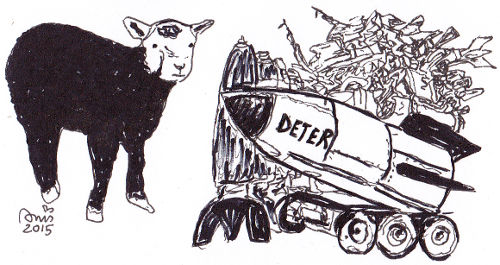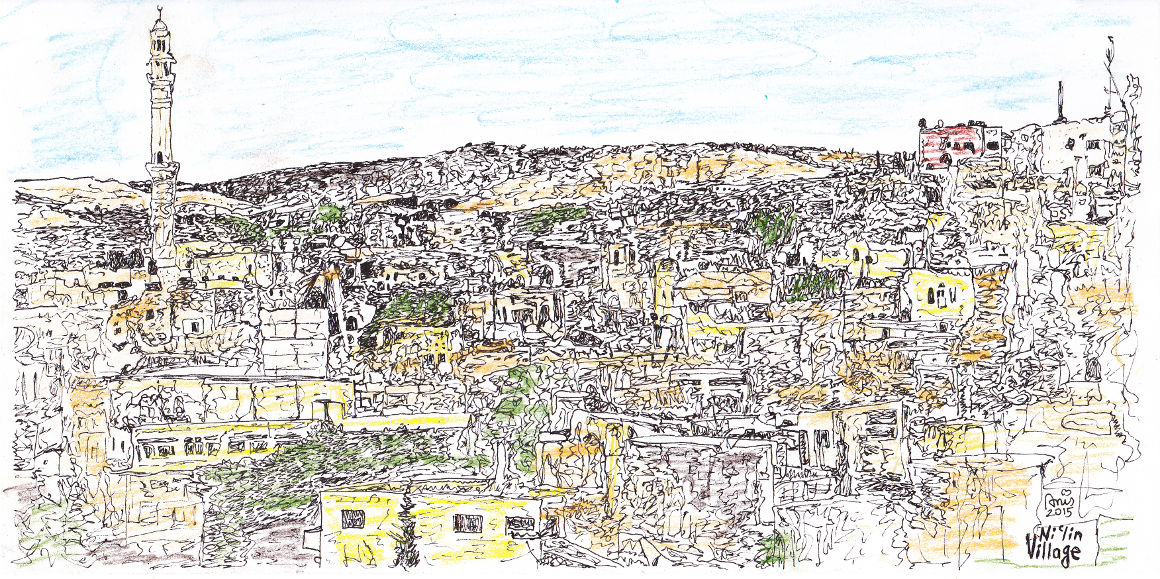
 |
home ao english musik literatur journalismus bilder sprachen mehr shop sitemap | |
| ESSAY (31) |
| Essay über die Stellung gewaltloser Strategien Anis Hamadeh, 19.03.2015 Inhalt: Intro – Das Glaubenssystem der Gewalt – Schwarze Panther – Gewaltloser Widerstand – Der Fall Palästina – Die Zeiten haben sich schon lange geändert – Das Glaubenssystem des Friedens Auf der einen Seite nehmen gewalttätige Konflikte und ein allgemeiner Friedenspessimismus seit dem Elften September zu, auf der anderen Seite gibt es einen offenbar unumkehrbaren Trend zur weltweiten Abschaffung der Todesstrafe,1 einen globalen Trend zur Anerkennung von Kriegsdienstverweigerung2 sowie zunehmende internationale Verflechtungen in der Online-Welt, für die das gewaltlose Miteinander von großer wirtschaftlicher, kultureller und menschlicher Bedeutung ist.
In der Tierwelt stellt sich die Frage nach dem Glaubenssystem der Gewalt nicht. Ohne Fressen und Gefressen-Werden gäbe es die uns bekannte Tierwelt erst gar nicht. Menschen hingegen haben ein Problem: Sie können denken. (Dies ist übrigens wahrscheinlich das beste Argument für Vegetarismus.) Und wer es kann, der praktiziert es auch hin und wieder und benötigt für diese zusätzliche, abstrakte Welt Orientierungspunkte. Diese nenne ich in ihrer Gesamtheit ein Glaubenssystem. Es hat mehr mit einem Wertesystem und einer Lebensphilosophie zu tun als mit Religion und meint auch keinen Gegensatz zur Wissenschaft. |
Anis Hamadeh, March 19, 2015 Content: Intro – The Belief System of Violence – Black Panthers – Nonviolent Resistance – The Case of Palestine – Times Have Changed Long Ago – The Belief System of Peace On the one hand, violent conflicts and a general peace pessimism have increased since 9/11, on the other hand, there apparently is an irreversible trend toward the worldwide abolition of the death penalty,1 a global trend toward the recognition of conscientious objection2 as well as increasing international interdependences in the online world in which nonviolent cooperation is of prominent significance in terms of economics, culture and humanity.
In the animal kingdom, the question of a belief system of violence does not occur. It's eat or be eaten, otherwise there would not be the animal kingdom as we know it to begin with. Humans, however, have a problem: They can think. (This, by the way, is probably the best argument for vegetarism.) And when you can you will exercise this ability from time to time and need orientational landmarks for this additional, abstract world. These in their entirety I call a belief system. It is about values and the philosophy of life rather than about religion; neither does it imply to mean an opposite of science. |
Dieser akademische Zweig heißt „Kognitive Linguistik“ und beschäftigt sich mit dem Verhältnis zwischen Sprache, Denken und Bewusstsein. Der Pionier Lakoff wies nach, dass wir in Metaphern denken und nur so überhaupt denken können. Das abstrakte Phänomen Zeit zum Beispiel können wir uns nur als etwas konkret Gehendes oder Reifendes oder Materielles vorstellen. Wenn sich mehrere Metaphern zu einem Ganzen kombinieren, nennt er das ein „Szenario“. |
 Deterrence of the black sheep / Abschreckung des Schwarzen Schafes |
This academic branch is called "Cognitive Linguistics" and deals with the relationship between language, thought and awareness. Pioneer Lakoff established that we think in metaphors and cannot do without them. Thus we can, for example, only conceptualize the abstract phenomenon of time in terms of something concretely moving in space or something riping or something material. When metaphors combine to a set he calls this a "scenario". |
Das heißt auch: Wenn alle glauben, dass Gewalt das stärkste Mittel ist, dann wird Gewalt tatsächlich zum stärksten Mittel. Ich spreche hier nicht von den Ausnahmesituationen der konkreten Selbstverteidigung. Auch ist klar, dass ein unbewaffnetes Dorf keiner bewaffneten Armee standhält, wenn diese angreift. Vielmehr geht es hier um die Art, wie wir denken, denn das ist es, was zu den großen Katastrophen führt: unpassende Szenarios, Feindbilder, zweierlei Maß, Missverständnisse, Ängste, Abstraktionen und unreflektiertes Machtstreben.
Kürzlich gewann der Dokumentarfilm „The Black Panthers: Vanguard of the Revolution“ von Stanley Nelson einen Preis beim berühmten Sundance Film Festival in den USA. Es wird kein Zufall sein, dass dieses Thema heute attraktiv ist. Vielleicht gibt es Umfragen darüber, wer eher für Martin Luther King und wer zu Malcolm X hält, dem Wegbereiter der Panther. Unbestritten ist wohl, dass die beiden Persönlichkeiten zwei Pole markieren, an denen sich Glaubenssysteme scheiden. James Cone bietet in seinem Buch über die beiden7 tiefe Einsichten in die unterschiedlichen Glaubenssysteme, versinnbildlicht in Kings „Traum“-Szenario und Malcolm X' "Albtraum"-Szenario. In Diskussionen über die anhaltenden Ereignisse in Ferguson und anderswo werden ebenfalls Fragen gestellt, die diese Kluft betreffen. Betrachten wir also die signifikante Aussage einer Black-Panther-Aktivistin, Kathleen Cleaver, aus einem kürzlich gegebenen Interview mit Amy Goodman von Democracy Now!, und analysieren wir das zu Grunde liegende Glaubenssystem etwas genauer, wenn sie über Martin Luther King sagt: „Wir hatten allerdings das Problem mit ihm, dass wir Schwarze die permanente Unterdrückung ertragen und uns in Vergebung üben und angesichts der mörderischen Brutalität des Vietnamkriegs selber friedfertig bleiben sollten. Das war nicht gerade die Art von Botschaft, die junge Leute hören wollten. Als dann die Black Panthers an die Öffentlichkeit gingen und über Selbstverteidigung sprachen, wollten Scharen von jungen Leuten genau das. Und ich dachte, das war das Beste, das ist das Beste – wir folgten Robert Williams. Der sagte, wenn du von einem Weißen konfrontiert wirst, der denkt, er sei etwas Besseres, und wenn du bewaffnet bist, dann muss er sich überlegen, ob er sein überlegenes Leben riskieren will, um dir dein unterlegenes Leben wegzunehmen. Wenn du eine Waffe trägst, kannst du ihn in diese Lage bringen. In neun von zehn Fällen wird er es nicht tun und damit hört die Gewalt auf. Deshalb waren wir der Ansicht, dass Selbstverteidigung eine Methode war, Gewalt zu reduzieren, und dazu stehe ich.“8 |
This also means: If everybody believes that violence is the strongest means then violence will indeed become the strongest means. I do not speak about exceptional situations of concrete self-defense here. It also goes without saying that an unarmed village will not withstand an armed army when it is attacking. Rather, this is about the way we think, for this is what leads us into the big catastrophes: unfitting scenarios, bogeyman images, double standards, misunderstandings, fears, abstractions and careless mind games. Recently, the documentary "The Black Panthers: Vanguard of the Revolution" by Stanley Nelson was awarded at the famous Sundance Film Festival in the USA. It won't be a coincidence that the topic is attractive today. Maybe there are polls about who rather supports Martin Luther King and who Malcolm X, forerunner of the Panthers. In any case, it appears to be an undisputed fact that the two personalities manifest two poles that separate belief systems. James Cone, in his book about the two,7 offers profound insights into the diverging belief systems, epitomized in King's "dream" scenario and Malcolm X's "nightmare" scenario. The discussions about the ongoing events in Ferguson and elsewhere raise questions concerning this gap, too. So let's take a closer look at a significant statement by Black Panther activist Kathleen Cleaver, given recently in an interview with Amy Goodman from Democracy Now!, and analyze the underlying belief system a little further, when she says this about Martin Luther King: "That was one of the issues we had, that it was too much the black people should absorb all the punishment, and we should be forgiving, and we should want to be peaceful in the face of murderous brutality in the middle of the Vietnam War. Well, that wasn’t really a message that a lot of young people cared for. And so, when the Black Panthers came out and started talking about self-defense, droves and droves of young people wanted to do that. And I thought that was the best—that’s the best—we followed Robert Williams. And he said, if you are confronted by a racist who believes himself superior, then he has—and you’re armed—he has to consider, does he want to risk his superior life to take your inferior life? And if you have a gun, you can put him in that position. And nine times out of ten, he doesn’t, and that’s the end of the violence. So we believed self-defense was a way to put a reduction into violence, and I accept that."8 |
Das Schlüsselwort hier ist „Selbstverteidigung“, ein deutlicher Euphemismus für die Bedrohung einer Person mit der Waffe und die Bereitschaft zu schießen. Sei es der richtige Weg oder nicht, zunächst einmal müssen wir die Dinge beim Namen nennen, um uns klar zu machen, wovon wir überhaupt reden. „Selbstverteidigung“ wird hier als Antithese zu „friedfertig“ gebraucht; in diesem Denkrahmen ist der Begriff „gewaltloser Widerstand“ ein Widerspruch in sich. Interessant ist auch die relative Nähe zur Welt der Mode, in Ausdrücken wie „Avantgarde“ (im Titel der Doku), „Botschaft“, die Leute „wollten“ es, „du kannst“. Das klingt alles sehr sexy, als wollten die Panther gerade ins Studio gehen und mit Jimi Hendrix einen groovy Song einspielen. |
 Rev. Martin Luther King Jr. and Malcolm X in a Harlem hotel room in February 1965 / Martin Luther King Jr. und Malcolm X in einem Harlemer Hotelzimmer im Februar 1965 |
The key word here is "self-defense", an obvious euphemism for threatening someone at gunpoint, being prepared to shoot this person. Be it the right method or not, at first we have to call a spade a spade in order to make clear to ourselves what we are really talking about. "Self-defense" in the context at hand is used as an anti-thesis of "peaceful"; in this frame of thinking the concept "nonviolent resistance" is a contradiction in terms. Interesting is also the relative closeness to the world of fashion in expressions like "vangard" (in the docu title), "message", people "wanted" it, "you can". All this sounds very sexy, as if the Panthers were just about to go to the studio to record a groovy song with Jimi Hendrix. |
 The Palestinian village Ni'lin in the West Bank / Das palästinensische Dorf Ni'lin in der Westbank |
|
Rechts sieht man eine Zeichnung des Friedhofs von Abydos, zwischen Asiut und Luxor am Nil gelegen. In der oberen rechten Ecke sind Gräber aus der vordynastischen Zeit, einfach gestaltet, sogar die für die letzten Herrscher. Dann ist da ein qualitativer Sprung um das Jahr 3000. Es war eine Zeit, von der bekannt ist, dass sie florierend und friedvoll war. Ägypten war vereinigt. In einem Dokumentarfilm erklärt der Archäologe Professor Günter Dreyer dazu folgendes: „Die Energie, die vorher in die Unterwerfung Unterägyptens ging, war nun nicht mehr erforderlich. Die konnte woanders hinfließen, und hier fließt sie in Architektur.“18 Zwischen die Borsten sehen, das bedeutet auch, dass man untersuchen kann, was im Falle des Fehlens von Gewalt möglich ist, sei es auf der gesellschaftlichen oder der persönlichen Ebene. |
On the left you see a drawing of the Abydos cemetary, located on the Nile between Asyut and Luxor. In the top right corner there are graves from the pre-dynastic period, simply made, even those of the last rulers, and then there is a qualitative leap around the year 3000. It was a time known to have been prosperous and peaceful. Egypt was united. In a documentary, the archeologist Professor Günter Dreyer explains: "The energy that before was neccessary to submit lower Egypt could flow elsewhere. In this case into architecture."18 To look between the bristles also means that we can examine the possibilities of life in the absence of violence, be it on the social or on the personal level. |
 |
| Datenschutzerklärung und Impressum (data privacy statement and imprint) |